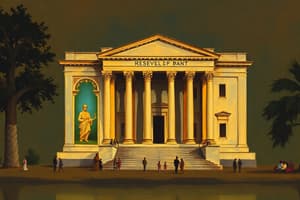Podcast
Questions and Answers
Which institution is solely authorized to print Indian currency?
Which institution is solely authorized to print Indian currency?
- State Bank of India
- Reserve Bank of India (correct)
- Ministry of Finance
- Indian Treasury Department
Which of the following locations does NOT have a facility for printing Indian currency notes?
Which of the following locations does NOT have a facility for printing Indian currency notes?
- Nasik
- Delhi (correct)
- Dewas
- Mysore
Who is recognized as the father of modern Indian currency?
Who is recognized as the father of modern Indian currency?
- Sher Shah Suri (correct)
- Raja Raja Chola
- Akbar the Great
- Mahatma Gandhi
In how many languages is the amount written on Indian currency notes?
In how many languages is the amount written on Indian currency notes?
What was the printing cost of banknotes in 2016?
What was the printing cost of banknotes in 2016?
Flashcards
Who prints Indian currency?
Who prints Indian currency?
The Reserve Bank of India (RBI) is the sole institution responsible for printing Indian currency notes.
Where are Indian currency notes printed?
Where are Indian currency notes printed?
Indian currency notes are printed at four facilities in India: Dewas, Nasik, Mysore, and Salboni.
How is the amount of currency printed decided?
How is the amount of currency printed decided?
The amount of currency printed each year is a confidential decision made between the RBI and the Ministry of Finance.
Who is considered the father of modern Indian currency?
Who is considered the father of modern Indian currency?
Sher Shah Suri is credited with introducing the first Rupiya in India and organizing the postal system.
Signup and view all the flashcards
How many languages are on Indian currency?
How many languages are on Indian currency?
Indian currency notes have the amount written in 17 different languages, including English, Hindi, Tamil, etc.
Signup and view all the flashcardsStudy Notes
Currency Printing in India
- The Reserve Bank of India (RBI) is the sole entity authorized to print Indian currency.
- Currency notes are printed in four locations in India: Dewas, Nasik, Mysore, and Salboni.
- The precise amount of currency printed annually is confidential, shared only between the RBI and the Ministry of Finance.
- In 2016, the RBI's banknote production and printing expenses reached ₹3,421 crore, related to 21.2 billion banknotes.
Father of Modern Indian Currency
- Sher Shah Suri is considered the founder of modern Indian currency.
- He introduced the Rupiya, derived from the Tanka, and established India's postal system.
Currency Note Languages
- Indian currency notes are printed in 17 languages, including Assamese, Bengali, English, Gujarati, Hindi, Kannada, Kashmiri, Konkani, Malayalam, Marathi, Nepali, Oriya, Punjabi, Sanskrit, Tamil, Telugu, and Urdu.
Security Features of Indian Currency Notes
- In 2000, the RBI incorporated a unique security feature in 500- and 1,000-rupee notes.
- The numeral figures on these notes appear green when viewed directly, but change to blue when observed from an angle.
Studying That Suits You
Use AI to generate personalized quizzes and flashcards to suit your learning preferences.




